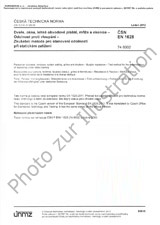Wir benötigen Ihre Einwilligung zur Verwendung der einzelnen Daten, damit Sie unter anderem Informationen zu Ihren Interessen einsehen können. Klicken Sie auf "OK", um Ihre Zustimmung zu erteilen.
ČSN ETSI EN 302729-V2.1.1 (875158)
Short Range Devices (SRD); Level Probing Radar (LPR) equipment operating in the frequency ranges 6 GHz to 8,5 GHz, 24,05 GHz to 26,5 GHz, 57 GHz to 64 GHz, 75 GHz to 85 GHz; Harmonised Standard covering the essential requirements of article 3.2 of the Directive 2014/53/EU
Name übersetzen
NORM herausgegeben am 1.6.2017
Informationen über die Norm:
Bezeichnung normen: ČSN ETSI EN 302729-V2.1.1
Zeichen: 875158
Katalog-Nummer: 502117
Ausgabedatum normen: 1.6.2017
SKU: NS-684719
Zahl der Seiten: 96
Gewicht ca.: 319 g (0.70 Pfund)
Land: Tschechische technische Norm
Kategorie: Technische Normen ČSN
Kategorie - ähnliche Normen:
Receiving and transmitting equipmentElectromagnetic compatibility in general
Die Annotation des Normtextes ČSN ETSI EN 302729-V2.1.1 (875158):
V2.1.1
The present document applies to the following equipment types:
Level Probing Radar (LPR) applications are based on pulse RF, FMCW, or similar wideband techniques.
The present document contains requirements to demonstrate that LPR equipment both effectively uses and supports the efficient use of radio spectrum in order to avoid harmful interference.
Table 1 shows a list of the frequency bands as assigned to Level Probing Radars in the European Commission Decision 2013/752/EU [i.13] on harmonised deployment conditions for industrial Level Probing Radars (LPR) as known at the date of publication of the present document.
Technical and regulatory requirements for LPR are provided in ECC Decision (11)02 [i.20], which are based on ECC Report 139 [i.8].
LPRs are used in many industries concerned with process control to measure the amount of various substances (mostly liquids or granulates). LPRs are used for a wide range of applications such as process control, custody transfer measurement (government legal measurements), water and other liquid monitoring, spilling prevention and other industrial applications. The main purposes of using LPRs are:
- - to increase reliability by preventing accidents;
- - to increase industrial efficiency, quality and process control;
- - to improve environmental conditions in production processes.
LPRs always consist of a combined transmitter and receiver and are used with an integral or dedicated antenna. The LPR equipment is for professional applications where installation and maintenance are performed by professionally trained individuals only.
NOTE: LPR antennas are always specific directive antennas and no LPR omnidirectional antennas are used. This is also important in order to limit the illuminated surface area as well as to control and limit the scattering caused by the edges of the surface.
The scope is limited to LPRs operating as Short Range Devices (SRD).
The LPR applications in the present document are not intended for communications purposes
Normansicht ČSN ETSI EN 302729-V2.1.1 (875158)
Empfehlungen:
Aktualisierung der technischen Normen
Wollen Sie sich sicher sein, dass Sie nur die gültigen technischen Normen verwenden?
Wir bieten Ihnen eine Lösung, die Ihnen eine Monatsübersicht über die Aktualität der von Ihnen angewandten Normen sicher stellt.
Brauchen Sie mehr Informationen? Sehen Sie sich diese Seite an.




 Cookies
Cookies
